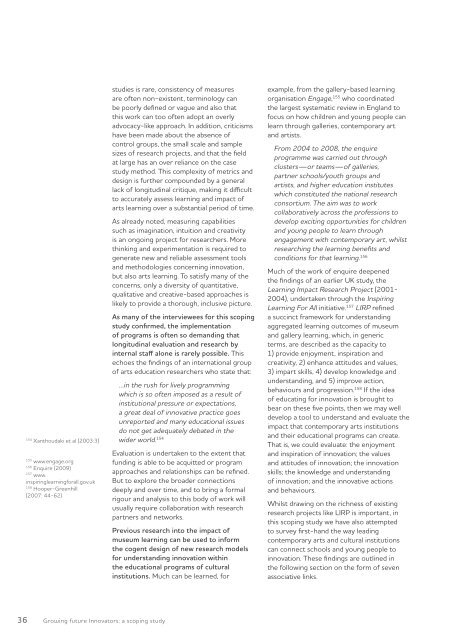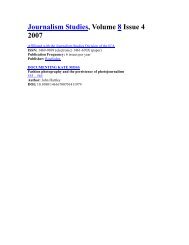GrowinG Future innovators - ARC Centre of Excellence for Creative ...
GrowinG Future innovators - ARC Centre of Excellence for Creative ...
GrowinG Future innovators - ARC Centre of Excellence for Creative ...
You also want an ePaper? Increase the reach of your titles
YUMPU automatically turns print PDFs into web optimized ePapers that Google loves.
36<br />
154 Xanthoudaki et al (2003:3)<br />
155 www.engage.org<br />
156 Enquire (2009)<br />
157 www.<br />
inspiringlearning<strong>for</strong>all.gov.uk<br />
158 Hooper-Greenhill<br />
(2007: 44-62)<br />
Growing future Innovators: a scoping study<br />
studies is rare, consistency <strong>of</strong> measures<br />
are <strong>of</strong>ten non-existent, terminology can<br />
be poorly defined or vague and also that<br />
this work can too <strong>of</strong>ten adopt an overly<br />
advocacy-like approach. In addition, criticisms<br />
have been made about the absence <strong>of</strong><br />
control groups, the small scale and sample<br />
sizes <strong>of</strong> research projects, and that the field<br />
at large has an over reliance on the case<br />
study method. This complexity <strong>of</strong> metrics and<br />
design is further compounded by a general<br />
lack <strong>of</strong> longitudinal critique, making it difficult<br />
to accurately assess learning and impact <strong>of</strong><br />
arts learning over a substantial period <strong>of</strong> time.<br />
As already noted, measuring capabilities<br />
such as imagination, intuition and creativity<br />
is an ongoing project <strong>for</strong> researchers. More<br />
thinking and experimentation is required to<br />
generate new and reliable assessment tools<br />
and methodologies concerning innovation,<br />
but also arts learning. To satisfy many <strong>of</strong> the<br />
concerns, only a diversity <strong>of</strong> quantitative,<br />
qualitative and creative-based approaches is<br />
likely to provide a thorough, inclusive picture.<br />
As many <strong>of</strong> the interviewees <strong>for</strong> this scoping<br />
study confirmed, the implementation<br />
<strong>of</strong> programs is <strong>of</strong>ten so demanding that<br />
longitudinal evaluation and research by<br />
internal staff alone is rarely possible. This<br />
echoes the findings <strong>of</strong> an international group<br />
<strong>of</strong> arts education researchers who state that:<br />
…in the rush <strong>for</strong> lively programming<br />
which is so <strong>of</strong>ten imposed as a result <strong>of</strong><br />
institutional pressure or expectations,<br />
a great deal <strong>of</strong> innovative practice goes<br />
unreported and many educational issues<br />
do not get adequately debated in the<br />
wider world. 154<br />
Evaluation is undertaken to the extent that<br />
funding is able to be acquitted or program<br />
approaches and relationships can be refined.<br />
But to explore the broader connections<br />
deeply and over time, and to bring a <strong>for</strong>mal<br />
rigour and analysis to this body <strong>of</strong> work will<br />
usually require collaboration with research<br />
partners and networks.<br />
Previous research into the impact <strong>of</strong><br />
museum learning can be used to in<strong>for</strong>m<br />
the cogent design <strong>of</strong> new research models<br />
<strong>for</strong> understanding innovation within<br />
the educational programs <strong>of</strong> cultural<br />
institutions. Much can be learned, <strong>for</strong><br />
example, from the gallery-based learning<br />
organisation Engage, 155 who coordinated<br />
the largest systematic review in England to<br />
focus on how children and young people can<br />
learn through galleries, contemporary art<br />
and artists.<br />
From 2004 to 2008, the enquire<br />
programme was carried out through<br />
clusters—or teams—<strong>of</strong> galleries,<br />
partner schools/youth groups and<br />
artists, and higher education institutes<br />
which constituted the national research<br />
consortium. The aim was to work<br />
collaboratively across the pr<strong>of</strong>essions to<br />
develop exciting opportunities <strong>for</strong> children<br />
and young people to learn through<br />
engagement with contemporary art, whilst<br />
researching the learning benefits and<br />
conditions <strong>for</strong> that learning. 156<br />
Much <strong>of</strong> the work <strong>of</strong> enquire deepened<br />
the findings <strong>of</strong> an earlier UK study, the<br />
Learning Impact Research Project (2001-<br />
2004), undertaken through the Inspiring<br />
Learning For All initiative. 157 LIRP refined<br />
a succinct framework <strong>for</strong> understanding<br />
aggregated learning outcomes <strong>of</strong> museum<br />
and gallery learning, which, in generic<br />
terms, are described as the capacity to<br />
1) provide enjoyment, inspiration and<br />
creativity, 2) enhance attitudes and values,<br />
3) impart skills, 4) develop knowledge and<br />
understanding, and 5) improve action,<br />
behaviours and progression. 158 If the idea<br />
<strong>of</strong> educating <strong>for</strong> innovation is brought to<br />
bear on these five points, then we may well<br />
develop a tool to understand and evaluate the<br />
impact that contemporary arts institutions<br />
and their educational programs can create.<br />
That is, we could evaluate: the enjoyment<br />
and inspiration <strong>of</strong> innovation; the values<br />
and attitudes <strong>of</strong> innovation; the innovation<br />
skills; the knowledge and understanding<br />
<strong>of</strong> innovation; and the innovative actions<br />
and behaviours.<br />
Whilst drawing on the richness <strong>of</strong> existing<br />
research projects like LIRP is important, in<br />
this scoping study we have also attempted<br />
to survey first-hand the way leading<br />
contemporary arts and cultural institutions<br />
can connect schools and young people to<br />
innovation. These findings are outlined in<br />
the following section on the <strong>for</strong>m <strong>of</strong> seven<br />
associative links.




![Plebiscite (Riegert chapter) revised FINAL [Feb 14].pdf](https://img.yumpu.com/8710373/1/190x245/plebiscite-riegert-chapter-revised-final-feb-14pdf.jpg?quality=85)